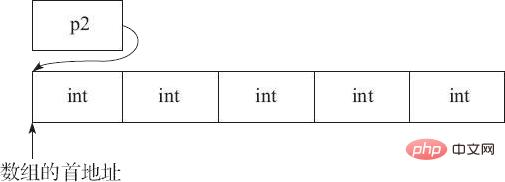 Backend Development
Backend Development
 C#.Net Tutorial
C#.Net Tutorial
 What is the difference between array pointer and pointer array
What is the difference between array pointer and pointer array
What is the difference between array pointer and pointer array
Difference: The pointer array itself is an array, and the elements of the array are pointers, that is, the array stores pointers. The number of bytes occupied by the array is determined by the array itself; and the array pointer itself is a pointer, which points to An array, that is, it is a pointer to an array, always occupies 4 bytes on a 32-bit system.

The operating environment of this tutorial: windows7 system, c99 version, Dell G3 computer.
I believe many C programmers will be confused about the concepts of pointer arrays and array pointers. Let's analyze the difference between the two through two simple statements. The sample code is as follows:
int *p1[5]; int (*p2)[5];
First, for the statement "int*p1[5]", because "[]" takes precedence The level is higher than "*", so p1 is first combined with "[]" to form the definition of an array. The array is named p1, and "int*" modifies the content of the array, that is, each element of the array. That is, the array contains 5 pointers to int type data, as shown in Figure 1, therefore, it is an array of pointers.

Secondly, for the statement "int(*p2)[5]", "()" has a higher priority than "[]", and the "*" sign and p2 It constitutes the definition of a pointer. The pointer variable is named p2, and int modifies the content of the array, that is, each element of the array. That is, p2 is a pointer that points to an array containing 5 int type data, as shown in Figure 2. Obviously, it is an array pointer. The array has no name here and is an anonymous array.

It can be seen that for a pointer array, first of all, it is an array, and the elements of the array are pointers. That is to say, the array stores pointers, and the array occupies The number of bytes is determined by the array itself; and for the array pointer, first of all, it is a pointer, which points to an array, that is to say, it is a pointer to the array, which always occupies 4 bytes in a 32-bit system. As for it How many bytes the pointed array occupies cannot be determined, it depends on the specific situation.
After understanding the difference between pointer arrays and array pointers, continue to look at the following sample code:
int arr[5]={1,2,3,4,5};
int (*p1)[5] = &arr;
/*下面是错误的*/
int (*p2)[5] = arr;It is not difficult to see that in the above sample code, &arr refers to the entire The first address of the array, and arr refers to the first address of the first element of the array. Although they have different meanings, the values between the two are the same. Then the question arises, since the values are the same, why the statement "int(*p1)[5]=&arr" is correct, but the statement "int(*p2)[5]=arr" runs under some compilers An error message will appear.
In fact, the reason is very simple. In C language, the data types on both sides of the assignment symbol "=" must be the same. If they are different, explicit or implicit type conversion is required. Here, p1 and p2 are both array pointers, pointing to the entire array. The data types on both sides of the "=" sign in p1's definition are completely consistent, but the data types on both sides of the "=" sign in p2's definition are inconsistent (the type on the left is a pointer to the entire array, while the data type on the right is a pointer to a single character pointer), so an error message will be prompted.
Related recommendations: "C Language Video Tutorial"
The above is the detailed content of What is the difference between array pointer and pointer array. For more information, please follow other related articles on the PHP Chinese website!

Hot AI Tools

Undresser.AI Undress
AI-powered app for creating realistic nude photos

AI Clothes Remover
Online AI tool for removing clothes from photos.

Undress AI Tool
Undress images for free

Clothoff.io
AI clothes remover

Video Face Swap
Swap faces in any video effortlessly with our completely free AI face swap tool!

Hot Article

Hot Tools

Notepad++7.3.1
Easy-to-use and free code editor

SublimeText3 Chinese version
Chinese version, very easy to use

Zend Studio 13.0.1
Powerful PHP integrated development environment

Dreamweaver CS6
Visual web development tools

SublimeText3 Mac version
God-level code editing software (SublimeText3)

Hot Topics
 1669
1669
 14
14
 1428
1428
 52
52
 1329
1329
 25
25
 1273
1273
 29
29
 1256
1256
 24
24
 C language data structure: data representation and operation of trees and graphs
Apr 04, 2025 am 11:18 AM
C language data structure: data representation and operation of trees and graphs
Apr 04, 2025 am 11:18 AM
C language data structure: The data representation of the tree and graph is a hierarchical data structure consisting of nodes. Each node contains a data element and a pointer to its child nodes. The binary tree is a special type of tree. Each node has at most two child nodes. The data represents structTreeNode{intdata;structTreeNode*left;structTreeNode*right;}; Operation creates a tree traversal tree (predecision, in-order, and later order) search tree insertion node deletes node graph is a collection of data structures, where elements are vertices, and they can be connected together through edges with right or unrighted data representing neighbors.
 The truth behind the C language file operation problem
Apr 04, 2025 am 11:24 AM
The truth behind the C language file operation problem
Apr 04, 2025 am 11:24 AM
The truth about file operation problems: file opening failed: insufficient permissions, wrong paths, and file occupied. Data writing failed: the buffer is full, the file is not writable, and the disk space is insufficient. Other FAQs: slow file traversal, incorrect text file encoding, and binary file reading errors.
 How debian readdir integrates with other tools
Apr 13, 2025 am 09:42 AM
How debian readdir integrates with other tools
Apr 13, 2025 am 09:42 AM
The readdir function in the Debian system is a system call used to read directory contents and is often used in C programming. This article will explain how to integrate readdir with other tools to enhance its functionality. Method 1: Combining C language program and pipeline First, write a C program to call the readdir function and output the result: #include#include#include#includeintmain(intargc,char*argv[]){DIR*dir;structdirent*entry;if(argc!=2){
 CS-Week 3
Apr 04, 2025 am 06:06 AM
CS-Week 3
Apr 04, 2025 am 06:06 AM
Algorithms are the set of instructions to solve problems, and their execution speed and memory usage vary. In programming, many algorithms are based on data search and sorting. This article will introduce several data retrieval and sorting algorithms. Linear search assumes that there is an array [20,500,10,5,100,1,50] and needs to find the number 50. The linear search algorithm checks each element in the array one by one until the target value is found or the complete array is traversed. The algorithm flowchart is as follows: The pseudo-code for linear search is as follows: Check each element: If the target value is found: Return true Return false C language implementation: #include#includeintmain(void){i
 How to output a countdown in C language
Apr 04, 2025 am 08:54 AM
How to output a countdown in C language
Apr 04, 2025 am 08:54 AM
How to output a countdown in C? Answer: Use loop statements. Steps: 1. Define the variable n and store the countdown number to output; 2. Use the while loop to continuously print n until n is less than 1; 3. In the loop body, print out the value of n; 4. At the end of the loop, subtract n by 1 to output the next smaller reciprocal.
 C language multithreaded programming: a beginner's guide and troubleshooting
Apr 04, 2025 am 10:15 AM
C language multithreaded programming: a beginner's guide and troubleshooting
Apr 04, 2025 am 10:15 AM
C language multithreading programming guide: Creating threads: Use the pthread_create() function to specify thread ID, properties, and thread functions. Thread synchronization: Prevent data competition through mutexes, semaphores, and conditional variables. Practical case: Use multi-threading to calculate the Fibonacci number, assign tasks to multiple threads and synchronize the results. Troubleshooting: Solve problems such as program crashes, thread stop responses, and performance bottlenecks.
 How to define the call declaration format of c language function
Apr 04, 2025 am 06:03 AM
How to define the call declaration format of c language function
Apr 04, 2025 am 06:03 AM
C language functions include definitions, calls and declarations. Function definition specifies function name, parameters and return type, function body implements functions; function calls execute functions and provide parameters; function declarations inform the compiler of function type. Value pass is used for parameter pass, pay attention to the return type, maintain a consistent code style, and handle errors in functions. Mastering this knowledge can help write elegant, robust C code.
 The concept of c language functions and their definition format
Apr 03, 2025 pm 11:33 PM
The concept of c language functions and their definition format
Apr 03, 2025 pm 11:33 PM
C language functions are reusable code blocks, receive parameters for processing, and return results. It is similar to the Swiss Army Knife, powerful and requires careful use. Functions include elements such as defining formats, parameters, return values, and function bodies. Advanced usage includes function pointers, recursive functions, and callback functions. Common errors are type mismatch and forgetting to declare prototypes. Debugging skills include printing variables and using a debugger. Performance optimization uses inline functions. Function design should follow the principle of single responsibility. Proficiency in C language functions can significantly improve programming efficiency and code quality.



